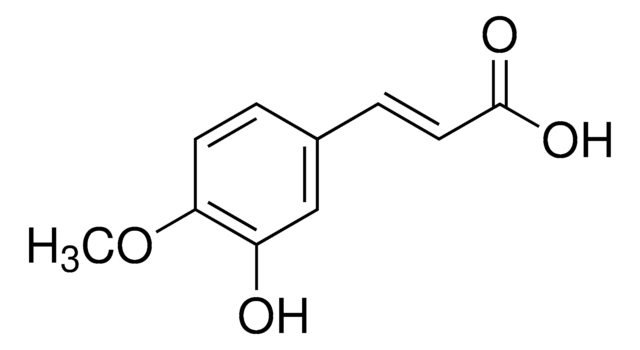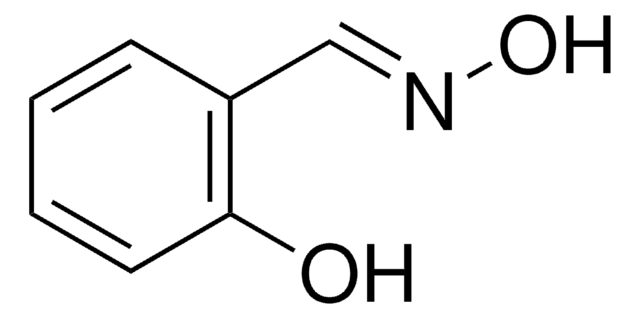103012
3-Hydroxy-4-methoxycinnamic acid, predominantly trans
97%
Sign Into View Organizational & Contract Pricing
All Photos(3)
About This Item
Linear Formula:
HOC6H3(OCH3)CH=CHCO2H
CAS Number:
Molecular Weight:
194.18
EC Number:
MDL number:
UNSPSC Code:
12352100
PubChem Substance ID:
NACRES:
NA.22
Recommended Products
Assay
97%
form
solid
mp
230 °C (dec.) (lit.)
SMILES string
COc1ccc(\C=C\C(O)=O)cc1O
InChI
1S/C10H10O4/c1-14-9-4-2-7(6-8(9)11)3-5-10(12)13/h2-6,11H,1H3,(H,12,13)/b5-3+
InChI key
QURCVMIEKCOAJU-HWKANZROSA-N
Related Categories
General description
3-Hydroxy-4-methoxycinnamic acid, predominantly trans is available as white crystals. 3-Hydroxy-4-methoxycinnamic acid is isolated from the aerial part of Artemisia capillaris, Chinese medicinal plant. It is a component of chinese herbal medicine used for a pain killer and stomachic. It is an efficient acetylcholine inhibitor. 3-Hydroxy-4-methoxycinnamic acid is bioactive metabolite of Spilanthes acmella Murr. It increases the resistance of low-density lipoprotein (LDL) to oxidation.
Application
3-Hydroxy-4-methoxycinnamic acid was used in the synthesis of tranilast and various tranilast analogs (cinnamoyl anthranilates) by genetically engineered Saccharomyces cerevisiae yeast strain. It was also used in the synthesis of glycoside compounds by undergoing glycosidation.
Storage Class Code
11 - Combustible Solids
WGK
WGK 2
Personal Protective Equipment
dust mask type N95 (US), Eyeshields, Gloves
Certificates of Analysis (COA)
Search for Certificates of Analysis (COA) by entering the products Lot/Batch Number. Lot and Batch Numbers can be found on a product’s label following the words ‘Lot’ or ‘Batch’.
Already Own This Product?
Find documentation for the products that you have recently purchased in the Document Library.
Customers Also Viewed
Supaluk Prachayasittikul et al.
Molecules (Basel, Switzerland), 14(2), 850-867 (2009-03-04)
Spilanthes acmella Murr. (Compositae) has been used as a traditional medicine for toothache, rheumatism and fever. Its extracts had been shown to exhibit vasorelaxant and antioxidant activities. Herein, its antimicrobial, antioxidant and cytotoxic activities were evaluated. Agar dilution method assays
Mathieu Renouf et al.
The Journal of nutrition, 140(2), 259-263 (2009-12-17)
Chlorogenic acids (CGA) are antioxidants found in coffee. They are becoming of interest for their health-promoting effects, but bioavailability in humans is not well understood. We hypothesized that adding whole milk or sugar and nondairy creamer to instant coffee might
T S Wu et al.
Bioorganic & medicinal chemistry, 9(1), 77-83 (2001-02-24)
Five new constituents including a flavonoid, artemisidin A (1), and four coumarins, artemicapins A (2), B (3), C (4) and D (5), together with 70 known compounds (6-75), have been isolated and characterized from the aerial part of Artemisia capillaris.
Dominik Szwajgier
Zeitschrift fur Naturforschung. C, Journal of biosciences, 68(3-4), 125-132 (2013-07-04)
The ability of 36 phenolic acids and their derivatives to inhibit acetyl- and butyrylcholinesterase was studied. The most efficient acetylcholine inhibitors were: carnosic acid = gentisic acid > 3-hydroxy-4-methoxycinnamic acid = ethyl ferulate = ethyl vanillate = nordihydroguaiaretic acid >
Mariana Monteiro et al.
The Journal of nutrition, 137(10), 2196-2201 (2007-09-22)
Chlorogenic acids (CGA) are abundant phenolic compounds in coffee, with caffeoylquinic (CQA), feruloylquinic (FQA), and dicaffeoylquinic (diCQA) acids being the major subclasses. Despite the potential biopharmacological properties attributed to these compounds, little is known about their bioavailability in humans. In
Our team of scientists has experience in all areas of research including Life Science, Material Science, Chemical Synthesis, Chromatography, Analytical and many others.
Contact Technical Service








